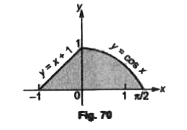Compute the area of the figure bounded by the curve √x+√y=1 and the straight line x+y=1
To compute the area of the figure bounded by the curve √x+√y=1 and the straight line x+y=1, we will follow these steps:
Step 1: Find the points of intersection
To find the area between the two curves, we first need to determine the points where they intersect.
1. From the line equation x+y=1, we can express y in terms of x:
y=1−x
2. Substitute y into the curve equation √x+√y=1:
√x+√1−x=1
3. Square both sides to eliminate the square roots:
x+(1−x)+2√x(1−x)=1
Simplifying gives:
2√x(1−x)=0
This implies:
√x(1−x)=0
Therefore, x(1−x)=0, which gives x=0 or x=1.
4. The corresponding y values are:
- If x=0, then y=1.
- If x=1, then y=0.
Thus, the points of intersection are (0,1) and (1,0).
Step 2: Set up the area integral
The area A between the curves from x=0 to x=1 can be expressed as:
A=Area of triangle−Area under the curve
1. The area of the triangle formed by the points (0,1), (1,0), and (0,0) is:
Areatriangle=12×base×height=12×1×1=12
2. The area under the curve √x+√y=1 can be rewritten as y=(1−√x)2. We will integrate this from x=0 to x=1:
Acurve=∫10(1−√x)2dx
Step 3: Calculate the area under the curve
1. Expand the integrand:
(1−√x)2=1−2√x+x
2. Now, integrate term by term:
Acurve=∫10(1−2√x+x)dx=∫101dx−2∫10√xdx+∫10xdx
3. Calculate each integral:
- ∫101dx=1
- ∫10√xdx=23
- ∫10xdx=12
4. Substitute back:
Acurve=1−2⋅23+12=1−43+12
5. Convert to a common denominator (6):
Acurve=66−86+36=16
Step 4: Calculate the final area
Now, we can find the area between the curves:
A=Areatriangle−Acurve=12−16
Convert 12 to sixths:
12=36
Thus,
A=36−16=26=13
Final Answer
The area of the figure bounded by the curve √x+√y=1 and the line x+y=1 is:
13
To find the area between the two curves, we first need to determine the points where they intersect.
y=1−x
√x+√1−x=1
x+(1−x)+2√x(1−x)=1
Simplifying gives:
2√x(1−x)=0
This implies:
√x(1−x)=0
Therefore, x(1−x)=0, which gives x=0 or x=1.
- If x=0, then y=1.
- If x=1, then y=0.
The area A between the curves from x=0 to x=1 can be expressed as:
A=Area of triangle−Area under the curve
Areatriangle=12×base×height=12×1×1=12
Acurve=∫10(1−√x)2dx
1. Expand the integrand:
(1−√x)2=1−2√x+x
Acurve=∫10(1−2√x+x)dx=∫101dx−2∫10√xdx+∫10xdx
- ∫101dx=1
- ∫10√xdx=23
- ∫10xdx=12
Acurve=1−2⋅23+12=1−43+12
Acurve=66−86+36=16
Now, we can find the area between the curves:
A=Areatriangle−Acurve=12−16
12=36
A=36−16=26=13
The area of the figure bounded by the curve √x+√y=1 and the line x+y=1 is:
13
Topper's Solved these Questions
- BOOK - IA MARONCHAPTER - APPLICATIONS OF THE DEFINITE INTEGRALEXERCISE - Computing Areas with Parametrically Represented Boundaries7videos
APPLICATIONS OF THE DEFINITE INTEGRAL
- BOOK - IA MARONCHAPTER - APPLICATIONS OF THE DEFINITE INTEGRALEXERCISE - The Area of a Curvilinear Sector in Polar Coordinates5videos
APPLICATIONS OF THE DEFINITE INTEGRAL
- BOOK - IA MARONCHAPTER - APPLICATIONS OF THE DEFINITE INTEGRALEXERCISE - Finding Average Values of a Function15videos
APPLICATIONS OF THE DEFINITE INTEGRAL
- BOOK - IA MARONCHAPTER - APPLICATION OF DIFFERENTIAL CALCULUS TO INVESTIGATION OF FUNCTIONSEXERCISE - ADDITIONAL PROBLEMS9videos
APPLICATION OF DIFFERENTIAL CALCULUS TO INVESTIGATION OF FUNCTIONS
- BOOK - IA MARONCHAPTER - BASIC CLASSES OF INTEGRABLE FUNCTIONS EXERCISE - 5.8 INTEGRATION OF OTHER TRANSCENDENTAL FUNCTIONS5videos
BASIC CLASSES OF INTEGRABLE FUNCTIONS
Similar Questions
Knowledge Check
- Question 1 - Select One
The area of the figure bounded by the curve |y|=1−x2, is
A2/3B4/3C8/3D−5/3 - Question 2 - Select One
The area of the figure bounded by the curve |y|−1−x2, is
A23B43C83DNone - Question 3 - Select One
The area of the region bounded by the curve x2=4y and the straight line x=4y−2 is
A38sq unitsB58 sq unitC78 sq unitD98 sq units
Find the area bounded by the curve y=2x−x2 and the straight line y=−x
View SolutionFind the value of ‘c’ for which the area of the figure bounded by the curve, y=8x2–x5, the straight lines x = 1 and x = c and the abscissa axis is equal to 16/3.
View SolutionThe area of the region bounded by the curve x2=4y and the straight line x=4y−2 is
View SolutionThe area of the figure bounded by the curves y2=2x+1 and x−y−1=0 , is
View SolutionWhat is the area bounded by the curves y=e^x, y=e^(-x) and the straight line x=1?
View Solution


